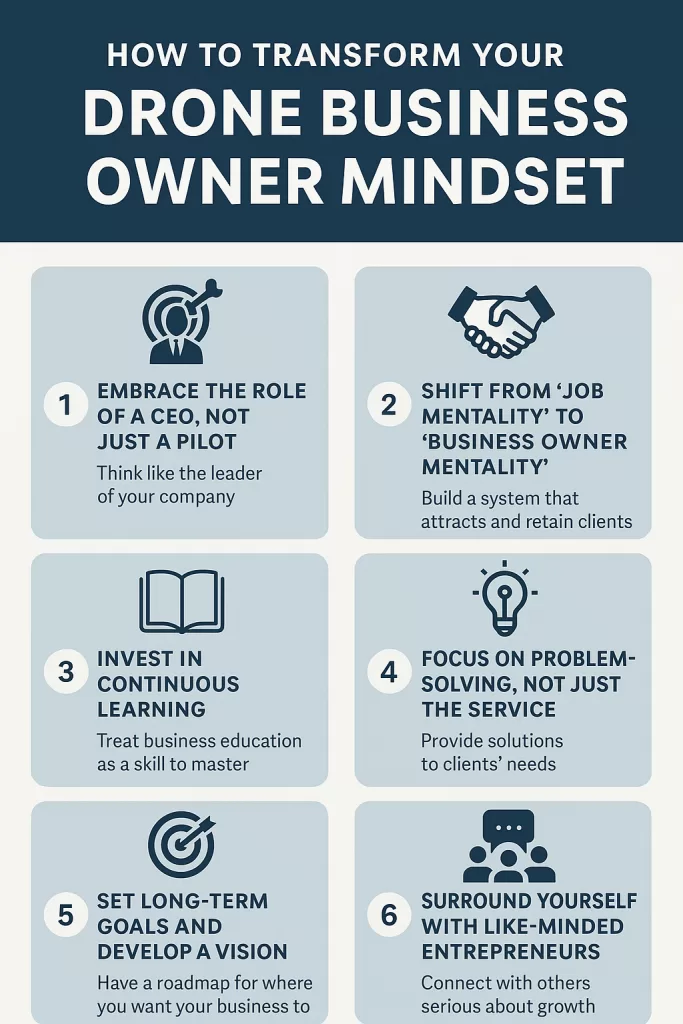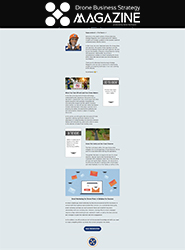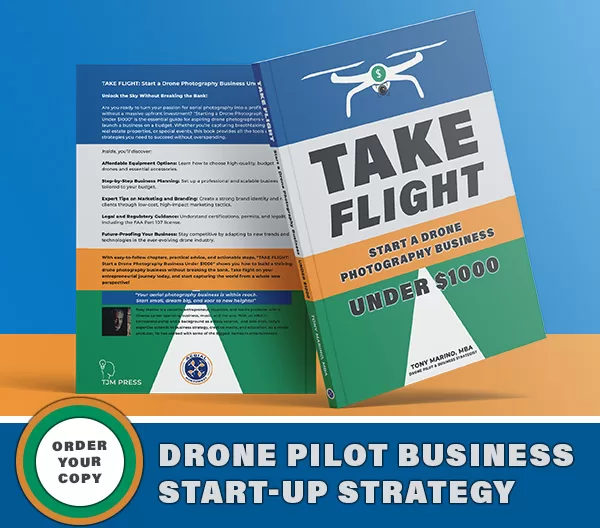
Starting a drone service business is an exhilarating endeavor. Whether you’re capturing breathtaking aerial shots, exploring new landscapes, or offering specialized services to clients, the excitement of flying drones for work is a huge draw. But here’s the thing: while many new drone pilots focus heavily on getting their Part 107 certificate, selecting the right equipment, and mastering the art of flight, far fewer put the same energy into learning business strategy.
As a drone business expansion strategist, I’ve seen this all too often. There’s a tendency to think that if you can fly well, the business side of things will fall into place on its own. But unfortunately, that’s not how it works. And it’s why so many drone service businesses either plateau or fail.
So, why do so many drone pilots ignore business strategy? And what happens when they do? More importantly—what can happen when they don’t?
The Root Cause: Overlooking Business Strategy
It’s no secret that drone pilots love flying. But here’s where the problem starts: many believe that mastering drone flight is the hardest part of running a business. It’s not. What separates successful drone businesses from the ones that struggle is the ability to manage clients, understand the market, develop a solid business model, and effectively market and sell services.
But for many, this part of the equation is an afterthought. Why?
1. Technical Overconfidence
It’s easy to assume that the skills required to operate a drone will be enough to run a profitable business. The reality is, flying a drone and running a business are two different skill sets. Just because you can shoot fantastic footage doesn’t mean you know how to get clients or handle the financials.
2. Lack of Awareness
Many drone pilots get their Part 107 certification, and with it, the excitement of diving straight into commercial work. But they skip over learning the nuances of running a business—marketing, pricing, client management, and business development—because they’re focused on just getting gigs.
3. Time Constraints
Running a business is time-consuming, and many drone pilots are already balancing their flying with other commitments. Learning about business strategy often gets pushed to the back burner because it’s harder to see the immediate return on investment compared to, say, flying a drone and getting paid for it.
What Happens When Drone Pilots Don’t Invest in Business Strategy?
The results are predictable when drone pilots skip over the crucial aspects of business strategy:
1. Inconsistent Income
Many drone pilots experience unpredictable income, primarily due to an ad hoc approach to client acquisition. When drone pilots don’t develop a clear strategy for attracting and retaining clients, they often end up in a cycle of “feast and famine”—securing a few high-paying jobs in one month and then struggling to find new clients the next. This inconsistency creates stress and uncertainty about the future of the business. Without the right systems in place, such as a robust marketing strategy, client follow-up processes, and solid networking channels, a drone business becomes highly unstable. There’s no consistent flow of work, and no way to predict when the next project will come in, making it difficult to plan financially or professionally. This leaves drone pilots at the mercy of the market, where external factors, such as seasonality or competition, can make or break their income.
To overcome this, drone pilots need to build a client acquisition and retention strategy that ensures steady work—whether through referrals, repeat clients, or a dependable marketing funnel. Building relationships with key clients who need recurring services can provide that consistent income stream and alleviate the feast-or-famine cycle.
2. Burnout
Running a drone business without a sustainable model often leads to burnout. When pilots are continually scrambling to secure the next gig, without adequate systems or workflows, the business becomes exhausting. Without a clear sense of direction or an organized approach, pilots find themselves juggling too many roles—marketing, sales, client service, operations—while still trying to fly and deliver quality work. This multitasking without sufficient structure can cause frustration and fatigue, as there’s no time to recharge or refine the business model.
In many cases, pilots become so focused on simply making money that they neglect the importance of efficiency and strategic planning. They push themselves to take on more work than is manageable or fail to delegate tasks, causing the stress to pile up. This constant pressure can drain energy, reduce creativity, and eventually lead to a collapse of the business.
To prevent burnout, drone pilots need to create a sustainable, scalable business model that includes time management strategies, outsourcing, and systematized processes. By streamlining operations and focusing on high-value tasks, pilots can build a business that’s both profitable and personally manageable.
3. Stunted Growth
The lack of a cohesive business strategy can also result in stagnation or “stunted growth.” Many drone pilots hit a ceiling when they don’t understand the critical elements of pricing, marketing, and sales. Without a proper pricing structure, they may undervalue their services, leading to underwhelming earnings. Without a marketing strategy, they may miss opportunities to expand their client base, and without an understanding of sales, they might struggle to close deals.
In addition, many pilots find themselves stuck doing the same types of work over and over, without thinking about how to diversify or scale their services. They may only offer basic aerial photography and fail to explore more profitable niches such as inspection services, 3D mapping, or real estate media packages. Additionally, not developing long-term relationships with clients can lead to a revolving door of one-off gigs, limiting opportunities for repeat business.
To break through the growth barrier, drone pilots need to understand how to price their services correctly, create a clear marketing plan to attract new clients, and develop strategies for upselling or cross-selling additional services. Diversifying offerings and nurturing existing client relationships can help pilots move beyond stagnation and achieve sustainable growth.
4. Risk of Failure
The drone industry is increasingly competitive, and without a solid business strategy, many drone pilots face a real risk of failure. In such a crowded market, it’s not enough to just fly drones well or offer basic services. Without a unique value proposition (UVP)—a clear differentiation from competitors—drone pilots risk blending into the sea of similar service providers.
Additionally, many new drone business owners lack the business acumen needed to navigate market changes, respond to client demands, or adapt to shifting industry trends. Without proper planning, financial management, and a growth-oriented mindset, a drone business can quickly lose its footing. Whether it’s poor cash flow management, ineffective marketing, or an inability to scale the business, these missteps can quickly snowball and lead to failure. In the worst-case scenario, a lack of business strategy can result in a complete shutdown.
To reduce the risk of failure, drone pilots must take the time to develop a business plan that outlines their UVP, establishes clear financial goals, and includes actionable steps for scaling their business. Creating a solid foundation and continuously refining strategies will ensure that their business not only survives but thrives in a competitive market.
By recognizing these potential pitfalls and proactively addressing them with a solid business strategy, drone pilots can avoid the common mistakes that lead to instability, burnout, and stagnation—and instead build a business that’s profitable, sustainable, and poised for growth.
What Happens When They Do?
When drone pilots take the time to learn and implement business strategy, the results can be game-changing. Here’s how it looks when you start pressing in on the business side of things:
1. Consistent Client Acquisition
When drone pilots develop a strong grasp of marketing, positioning, and relationship-building, they shift from chasing clients to consistently *attracting* them. This is a game-changer. Instead of relying on word-of-mouth, luck, or one-off job boards, they implement proven strategies that bring in a steady stream of leads. This includes building a recognizable brand, creating compelling content, targeting the right markets, and nurturing leads through well-designed sales funnels.
The key is having systems in place—email outreach, social proof, automated follow-ups, and strategic partnerships—that consistently generate interest and build trust. Once those systems are operating smoothly, the stress of finding work disappears. You know where your next project is coming from because you’ve engineered your business to produce opportunities on purpose, not by accident.
2. Sustainable Revenue
Sustainability in revenue comes from more than just getting paid—it comes from getting *paid well and consistently*. That happens when drone pilots take control of their pricing strategy, bundle their services into irresistible packages, and clearly communicate the value they bring to the table. When you stop offering random a la carte services and start positioning yourself as a solution provider, you create opportunities for bigger, more profitable projects.
Strategic pricing means charging based on value, not just time or deliverables. It also means designing offers that scale—like recurring real estate media packages, retainer agreements with commercial clients, or tiered pricing that meets different client needs. When your pricing aligns with your expertise and the market’s demand, you stop surviving and start thriving.
3. Scalability
A business that’s built on strategy is a business that’s ready to scale. That doesn’t mean growing for growth’s sake—it means growing intelligently. With the right foundation, drone pilots can expand their offerings into high-demand areas like thermal imaging, orthomosaic mapping, or marketing content creation for real estate and tourism. They can raise their rates with confidence, knowing their service quality, positioning, and brand support the increase.
Scaling also means getting your time back. You can bring on help—editors, second shooters, or even a virtual assistant—because your systems are dialed in. You’ve documented your workflows, automated your onboarding, and created predictable outcomes for your clients. That kind of growth doesn’t just increase revenue; it gives you freedom.
4. Long-Term Success
At the end of the day, the pilots who build real businesses—not just temporary side hustles—are the ones who understand that strategy drives longevity. You’re not guessing, reacting, or hoping you “get lucky.” You’re operating from a plan. You’re tracking your numbers. You’re improving your client experience. You’re showing up with intention every single day.
When you think strategically, you stop being “just another drone guy” and start becoming *the go-to expert* in your market. You earn a reputation. You build loyalty. You create something that can weather changes in technology, the economy, or the industry. And most importantly, you set yourself up for a business that doesn’t just work for now—but one that will support you and grow with you for years to come.
Transforming Your Mindset for Greater Success and Sustained Profitability
One of the most powerful shifts you can make as a drone business owner is a mindset shift—from being a pilot who just happens to own a business to being a true entrepreneur who understands that business is about more than just flying drones.
Here’s how to get started on that transformation:
1. Embrace the Role of a CEO, Not Just a Pilot
Your drone is a tool—you are the engine that drives the business. You’re not just flying missions; you’re building an enterprise. That means stepping up and owning every aspect of the business: strategy, operations, marketing, finance, and leadership. Start each week not just by checking your gear, but by checking your business dashboard. Where are your leads coming from? What’s your revenue projection? How’s client retention looking? CEOs think big picture. Be the visionary your business needs.
2. Shift from ‘Job Mentality’ to ‘Business Owner Mentality’
Many drone pilots unknowingly adopt a gig-worker mindset—chasing jobs, bidding low, working project to project with no long-term plan. That’s survival mode. A business owner, on the other hand, builds systems: lead generation, onboarding workflows, client nurturing, and follow-up strategies. You start thinking in terms of value delivery, profit margins, and scalability. You stop working in the business all the time and start working on it. That’s how you move from grind to growth.
3. Invest in Continuous Learning
You didn’t become a competent drone pilot without learning the rules of the sky—so don’t expect to become a competent business owner without learning the rules of business. Invest in business books, online courses, masterminds, podcasts, and workshops. Learn about sales psychology, copywriting, client retention, pricing strategies, and automation. Just one insight can shift your entire trajectory. Make learning a habit, not a one-time event. It’s the fuel for long-term success.
4. Focus on Problem-Solving, Not Just the Service
Clients don’t care that you fly drones—they care about the results your drone helps them achieve. Start asking better questions: What is the real outcome the client wants? Is it to sell a property faster? Save money on inspections? Showcase a venue or event in a way that drives traffic? Once you identify the problem, you can position your service as the solution—and suddenly, price becomes less of a barrier because you’re no longer selling a task; you’re delivering value.
5. Set Long-Term Goals and Develop a Vision
Operating without a vision is like flying without a flight plan—you might be moving, but you have no direction. Set clear goals: monthly revenue targets, client acquisition numbers, new markets to break into, and even personal time off. Then reverse-engineer your actions to support those goals. A vision gives you purpose and focus. It turns daily decisions into intentional moves. When you know where you’re going, it’s a lot easier to say yes to the right opportunities—and no to distractions.
6. Surround Yourself with Like-Minded Entrepreneurs
You’re only as strong as your network. Connect with others who are building, hustling, learning, and growing. The conversations are different when you’re around driven entrepreneurs—they challenge your assumptions, share ideas, and help you see blind spots. Whether it’s a local meetup, a virtual mastermind, or a mentorship relationship, surrounding yourself with business-minded peers accelerates your own growth. Energy is contagious. So is focus. Get around people who are going places.
Takeaway
You can have the coolest drone, the sharpest footage, and all the technical skill in the world—but if you don’t build your business on solid strategic ground, it won’t last.
This is about more than drones. This is about stepping into your full potential as a business owner.
So if you’ve been flying blind when it comes to business strategy, consider this your wake-up call.
There’s room at the top, but only if you’re willing to think like a leader, build like an entrepreneur, and fly with purpose.
Let’s get to work. Your future clients—and your bank account—are counting on it.
If you have any questions, let us know! If you’d like to hire us, you can get more information here.
Written by: Tony Marino, MBA – FAA Certified Part 107 Commercial Drone Pilot and Chief Business Strategist at Aerial Northwest
Disclaimer: The information provided in this blog post is for general informational purposes only and should not be construed as legal advice.

Drone Pilot MBA (Podcast):
Why Most Drone Pilots Ignore Business Strategy and Fail
Resources
FAA Resources: FAA DroneZone
Article: Pitch Perfect: Guide for Drone Pilots to Get Jobs
Drone Service Providers Alliance
Commercial Drone Alliance
Starting Your Own Drone Service Business
Pick up your copy today on Amazon and wherever fine books are sold.

DRONE BUSINESS STRATEGY MAGAZINE
A free digital publication made exclusively for all small business drone pilots to them help start-up, become profitable while sustaining a competitive advantage within the drone service industry sector they opt to serve.
“If you love to fly, we’d love to have you come aboard!”
We share your information with no one. Our Privacy Policy.










Leave a Reply
Your email is always safe with us.